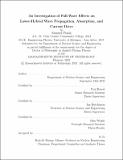An Investigation of Full-Wave Effects on Lower-Hybrid Wave Propagation, Absorption, and Current Drive
Author(s)
Frank, Samuel
DownloadThesis PDF (68.02Mb)
Advisor
Bonoli, Paul
Hutchinson, Ian
Terms of use
Metadata
Show full item recordAbstract
Lower hybrid current drive (LHCD) has been used as a radio-frequency (RF) heating and current drive actuator in tokamaks for over 40 years. However, despite being one of the first experimentally demonstrated sources of RF current drive, LHCD has never been consistently predicted by numerical simulation using coupled raytracing Fokker-Planck (FP) models. One frequently cited source of this discrepancy is the breakdown of the WKB approximation raytracing is based upon and "full-wave" effects such as diffraction and interference which raytracing cannot resolve. However, this claim has never been thoroughly investigated. In this work, we replace the raytracing model for wave propagation and damping in LHCD simulations with TORLH, a semi-spectral full-wave model that directly solves for the wave fields in order to assess the validity of raytracing. Using groundbreaking TORLH simulations, we demonstrate that in most modern tokamak core scenarios LHCD raytracing/FP calculations closely match full-wave/FP results. We found that previous discrepancies between raytracing and full-wave results in many cases can be attributed to improper controls and a lack of self-consistency in the full-wave/FP iteration. Our simulations of Alcator C-Mod, DIII-D, and the Experimental Advanced Superconducting Tokamak (EAST), suggest full wave effects are unlikely to be of particular importance in reactor-like scenarios where the LH wave is single pass damped, or even in modern experiments where the lower-hybrid wave is weakly damped.
Date issued
2023-02Department
Massachusetts Institute of Technology. Department of Nuclear Science and EngineeringPublisher
Massachusetts Institute of Technology